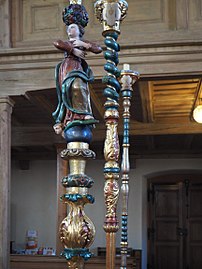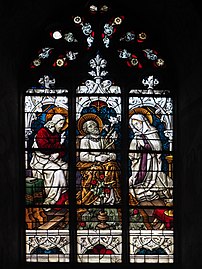St. Pankratius (Burkheim am Kaiserstuhl)
St. Pankratius is a Catholic parish church in Burkheim am Kaiserstuhl . She belongs to the pastoral care unit Vogtsburg in the deanery Breisach-Neuchâtel of the Archdiocese of Freiburg . The building, which is Gothic in its oldest parts, is located on the Kirchberg in the upper town of Burkheim.
Construction and building history
The construction of the church dates back to around 1350, when the structure was rebuilt at this point. A document from the Einsiedeln Monastery describes a precursor church called the Basilica of St. Petri, which, however, was located outside the city.
The oldest part of the current church is the Gothic choir from the 14th century. The sacristy was subsequently added to the north side of the choir, with the choir windows walled up there. This was followed by the construction of the late Gothic church tower in the 16th century (after Pastor E. Hettich, J. Sauer). The baroque nave construction is dated to the years 1740 to 1750 (after Hettich). In 1872/1876 a window axis was added to the nave. The western porch with the stepped gable also dates from this construction period .
The church tower, which is square in plan, ends with a pyramid roof . It has corner cuboids and is horizontally divided into three floors by belts. The upper floor shows a tracery adorned sound window on each side , below each a clock face of the tower clock is attached. A large tracery window is inserted on the north wall of the first floor .
inner space
The rectangular nave is a simple hall with arched windows . The Gothic choir adjoining in the east ends with three sides of an octagon. In the middle of the end of the choir there is still a Gothic window, but this is hidden from the inside by the high altar. The two laterally adjoining windows were reshaped in the baroque period. A special feature is the late Gothic tower hall ("Frauenchörle"), which protrudes into the nave. This is the lower floor of the church tower. This unusual position of the tower in the structure is due to the narrowness and the special features of the terrain.
Furnishing
Choir
Choir altar
The choir altar was created by local artists and craftsmen in the second half of the 18th century. The carpenter Prosper Danner, the painter Sebastian Nissle and the sculptor Casimir Friedrich were involved. The design was based on the crown altars of the old diocese of Strasbourg.
A gilded tabernacle block stands on the altar table . A crucifix surrounded by figures of angels is arranged in the center. The busts of the apostles Peter and Paul can be found on the outside .
The high altar tower rises behind it, supported by columns and pilasters , flanked by the statues of Joseph and John the Baptist . Two volute arches span the choir windows. From them go out two of the four brackets that carry a large crown. The crown appears to float above the tabernacle.
The central painting by the local painter Sebastian Nisslin was created in 1779, but was painted over in 1860. The church patron St. Pankratius is depicted on it. As a young warrior he kneels on a cloud over the city of Burkheim, behind him father, son and holy spirit. Arranged above the picture, a dove in a halo symbolizes the Holy Spirit and divine grace.
Sacrament niche
A sacrament niche in the choir wall dates from the late Gothic period, as can be seen from the decor.
Statue cabinet of the guilds
On the south side of the choir is the statue cabinet of the guilds. Its doors have baroque paintings of the guild saints Urban, Petrus and Josef as well as the church patron Pankratius.
Longhouse
Side altar and pulpit
The neo-Gothic side altar on the south wall of the choir was made by the Überlingen sculptor J. Eberle. It was erected in 1887 and replaced the old baroque altar of Mary. Depicted are the enthroned Madonna, mother Anna and Saint Joseph as a carpenter. The little decorated pulpit from 1896 is also in the neo-Gothic style. It was created by the sculptor Josef Dettlinger from Freiburg.
epitaph
The grave monument ( epitaph ) of the mayor Nicolaus Kieninger († 1743) is located on the southern wall of the nave . A relief shows the deceased kneeling in front of a crucifix. Mary appears to him as the queen of heaven on a cloud . The scene is crowned by a heraldic cartouche, under the relief an inscription cartouche is arranged. A draped curtain forms the frame. According to Pastor Manfred Hermann, the work of art comes from the Freiburg sculptor Anton Xaver Hauser (1712–1772).
Statues
The corner of the tower substructure facing the nave is adorned by two statues.
- A crowned figure of the Virgin Mary stands on a small pillar and was moved here from the demolished so-called Kreuzkapelle. Originally there was an older statue here, which was lost in the 19th century.
- A statue niche dated 1604 is embedded above the Marian column. This year can be found at the bottom of the niche. There is the baroque statue of St. Sebastian , which was created by the local artist Casimir Friedrich in the 18th century.
Guild poles
The three municipal guilds of farmers, craftsmen and fishermen used so-called guild poles as light carriers for processions and funerals. Six of these ornate poles with the guild coat of arms are set up on both sides of the rear central aisle. They probably come from the artist Casimir Friedrich from the 18th century.
Ceiling paintings and Stations of the Cross
The two ceiling paintings were created around 1912 by the Offenburg painter Friedel Hanselmann († 1931). They show the Annunciation and the birth of Christ . The 14 Stations of the Cross are from the time shortly before the First World War . They were painted by the painter Lessing from Munich in the Nazeren style.
Women's choirs
The lower tower floor (tower substructure, tower hall) has a chapel-like character and is also known as the “women's choir”. There you can see:
Baptismal font
It dates from the 15th century. The base and chalice are octagonal in shape and are wrapped in Gothic branches. The ornamental forms are not completely preserved, however, but show damage in the central area.
Former Choir crucifix
On the east wall hangs a larger than life crucifix from around 1480, which previously hung in the choir arch.
Reticulated vault with paintings
The room is spanned by a reticulated vault, in whose fields paintings from the Renaissance period can be seen. Surrounded by climbing plants, the symbols of the four evangelists are shown (Matthew angel / human, Luke bull, Markus lion, John eagle). The central keystone shows Mary with the baby Jesus.
Stained glass in the north window
The large window on the north side shows the death of Joseph , the patron saint of the craftsmen's guild. It was created in 1901 by the glass painter Merzweiler from Freiburg.
organ
The organ is on the gallery in the west of the nave. The baroque organ front probably comes from the Burkheim master AJ Pottier. On both sides of a powerful central tower, harp fields swinging outwards are arranged.
The pipe and musical mechanism was completely renewed in 1990 by the Mönch Organ Builder from Überlingen. It has two manuals and a pedal and 19 stops.
|
|
|
|||||||||||||||||||||||||||||||||||||||||||||||
- Coupling : II / I, II / P, I / P
Expertise: Hans Musch, Freiburg
Bells
St. Pankratius has a four-part bell. Only the oldest and smallest bell is made of bronze , the other three are steel bells. The bells hang in a steel bell cage on two floors. A fundamental renovation of the bells took place in 2010.
| Caster | material | Casting year | Weight in kg | Ø in mm | Chime | |
|---|---|---|---|---|---|---|
| 1 | Bochum Association | steel | 1951 | 1350 | 1510 | d′-4 |
| 2 | Bochum Association | steel | 1951 | 780 | 1256 | f′-4 |
| 3 | Bochum Association | steel | 1951 | 520 | 1110 | g′-4 |
| 4th | Konrad Zoller, Biberach | bronze | 1872 | 300 | 800 | b′-4 |
literature
- Hermann Brommer: St. Pankratius Burkheim am Kaiserstuhl. Schnell Art Guide No. 1914. Schnell & Steiner Verlag, 1991.
- E. Hettrich: Our parish church. In: Festschrift 1200 years of Burkheim. 1963.
- Futterer: Bells on the Kaiserstuhl.
- B. Sulzmann: Historical organs in Baden. Munich / Zurich 1980.
Web links
- Homepage of the pastoral care unit Vogtsburg
- Organ disposition on the Mönch Orgelbau company website
- Audio samples of the peal of St. Pankratius
Individual evidence
- ^ Hermann Brommer: St. Pankratius Burkheim am Kaiserstuhl , p. 3 f
- ^ H. Brommer: St. Pankratius Burkheim am Kaiserstuhl , p. 4.
- ^ H. Brommer: St. Pankratius Burkheim am Kaiserstuhl , p. 15.
- ^ H. Brommer: St. Pankratius Burkheim am Kaiserstuhl , pp. 16-22.
- ^ H. Brommer: St. Pankratius Burkheim am Kaiserstuhl , p. 20.
- ↑ Disposition taken from the website of Mönch Orgelbau http://moench-orgelbau.de/disposition,moench-orgel-156,a,3
- ↑ Data taken from the website http://www.ebfr-glocken.de/ - Erzdiözese Freiburg
















